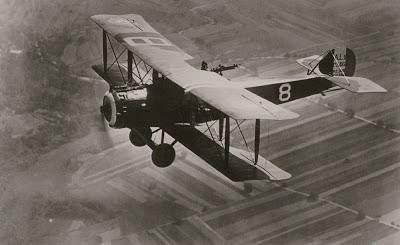The Avro 531 'Spider' was a one-off prototype that did not enter production simply because, apparently, said prototype was completed too late... a competitor, the Sopwith Snipe, had already been selected as the RFC/RAF's newest scout aeroplane by whomever did such selecting back then. The design utilized both newly-conceived and existing components, the latter coming primarily from the Avro 504. Actually, there was a second machine constructed which, although related to the Spider, was a bit different, mainly in the design of the wings and struts. This second aeroplane was envisioned as a racing machine, but it was never used as such. Both machines were employed as 'hacks' of a sort by Avro until the early 1920s.
Anyhoo, we think that's the straight dope on the Spider... admittedly, we've not taken much time to do research on this kite. We did however come across an article with a blurb about the Spider in an online PDF presentation of an old ish of 'Flight' magazine, and have reproduced the relevant text from that rag below.
But first, a pikshur!
Project 914 Archives
Alrighty, the following was taken from the March 20th, 1919 ish of 'Flight' magazine, which can be seen HERE...
The Avro 'Spider,' Type 531. April, 1918.
The following spring saw an entirely diferent type of machine issue from the Avro works. This was a single-seater 'Scout,' in which the wing bracing was along quite unusual lines. From the illustrations it will be seen that, instead of the ordinary wing bracing wires or cables, the 'Spider,' as this machine was called, had Vee struts arranged in the form of a Warren truss. It may be remembered that in 1917 we published in Flight a series of articles by 'Marco Polo,' entitled 'Wing Bracing and Head Resistance,' in which this particular form of wing bracing was dealt with.
In this article the author expressed the opinion that although the combination of Nieuport Vee struts and Warren truss did not appear to give the absolute minimum of resistance, it did have a low resistance, while at the same time having the structural advantage that the distance between supports was reduced, thus resulting in a lighter structure, and that therefore the arrangement might be found to be worth trying.
This appears to be what the Avro designer has done, and we may therefore be pardoned a certain special interest in this particular machine. We understand that the 'Spider' was extremely manoeuvrable and light on the controls, and the accompanying table of performance indicates that the machine had quite a good turn of speed--120 m.p.h. at ground level with a 130-h.p. Clerget engine is not bad--while the climb was also satisfactory. The pilot was so placed that his eyes were on a level with the top plane, in which a circular opening was cut out. This gave a good view both upwards and horizontally in all directions, while the small chord of the bottom plane gave a minimum of obstruction to downward visibility. The 'Spider' might conceivably make a good sporting model, especially if fitted with a somewhat smaller engine, since the petrol bill for a motor of 130 h.p. would probably be more than the majority of owners would care to spend. However, as the machine is light there does not appear to be any reason why, in a slightly modified form, it should not be fitted with, say, an engine of 80 h.p. or thereabouts.
Fade to Black...










